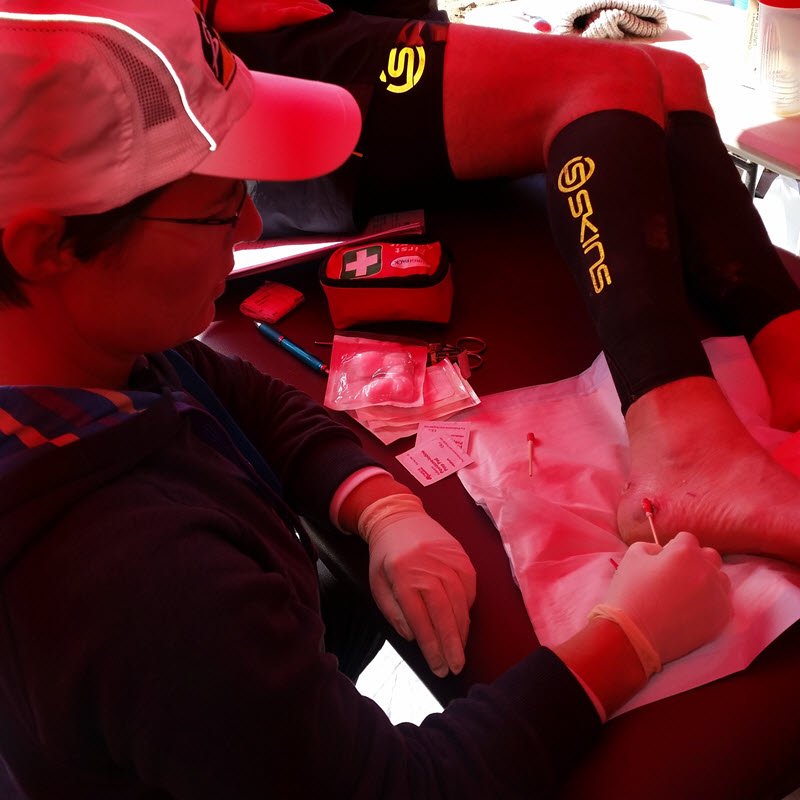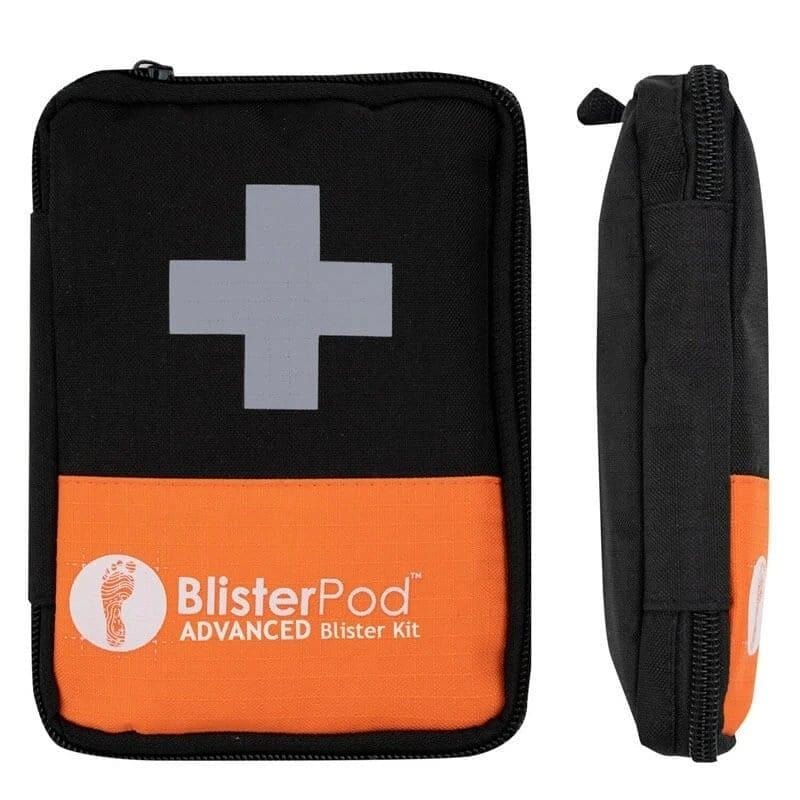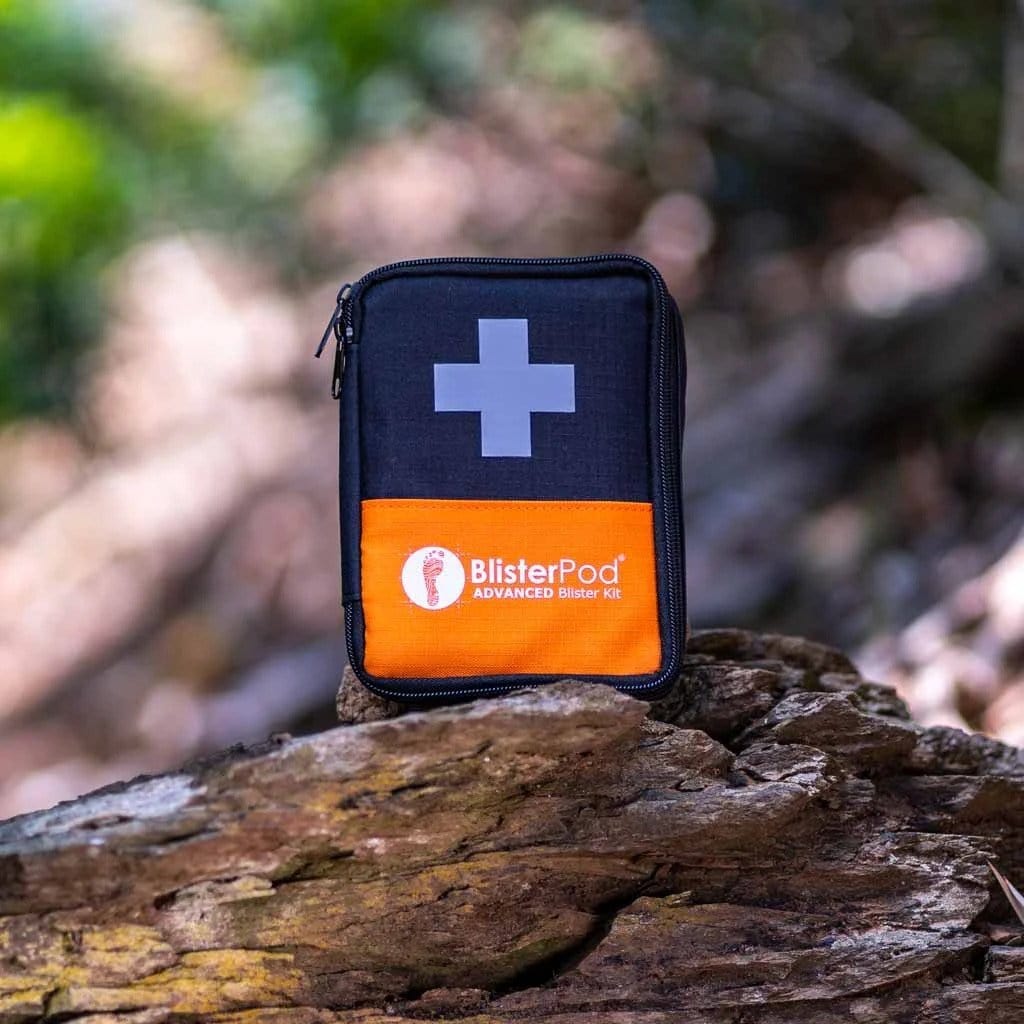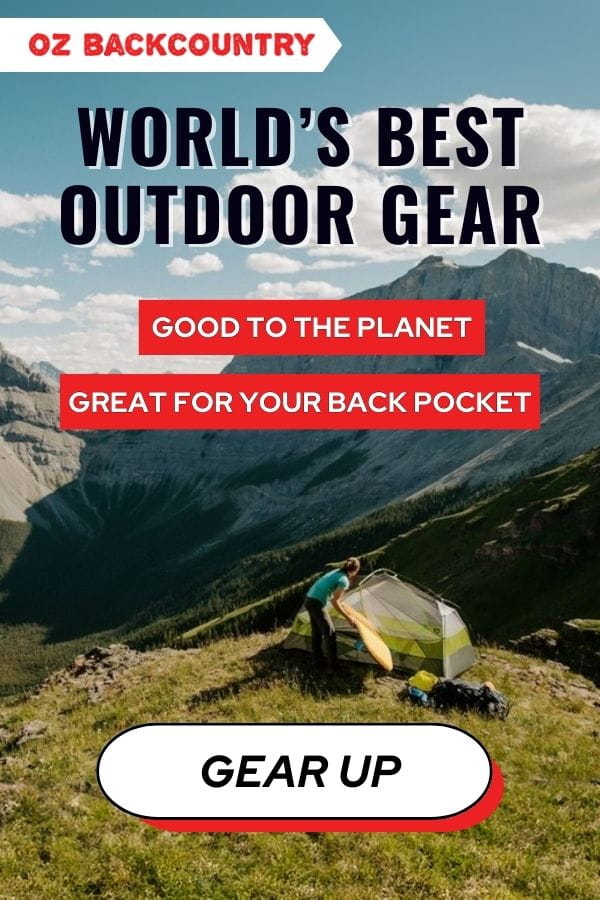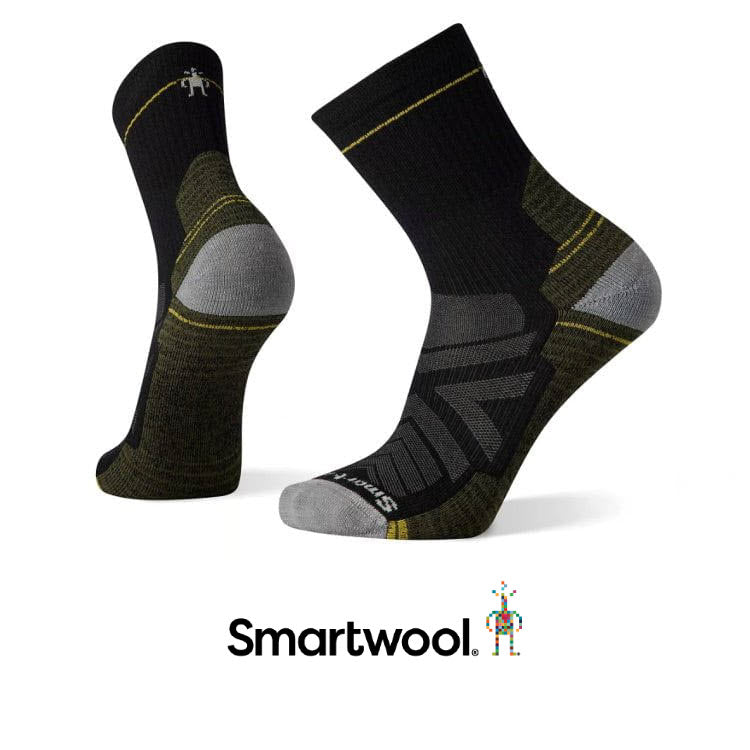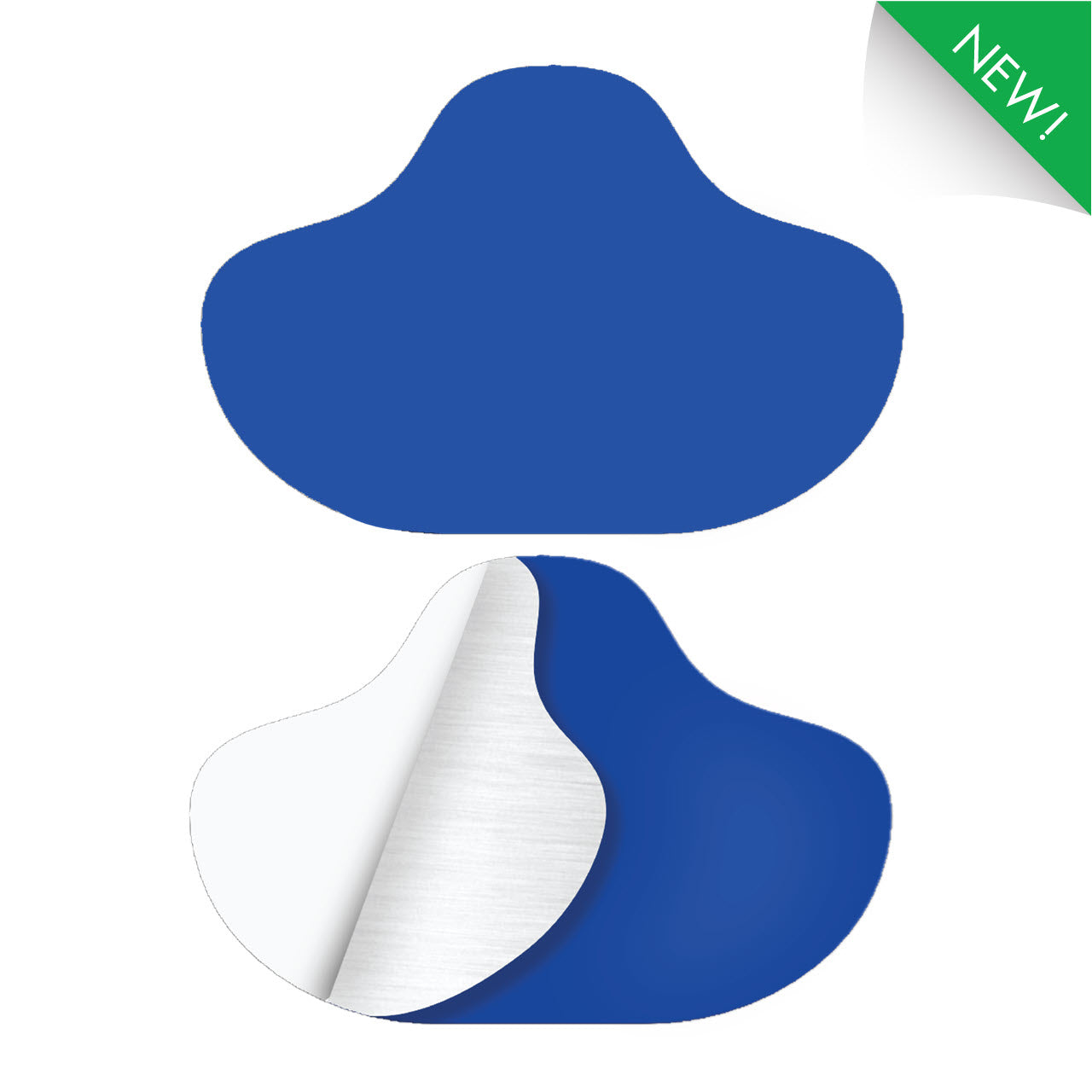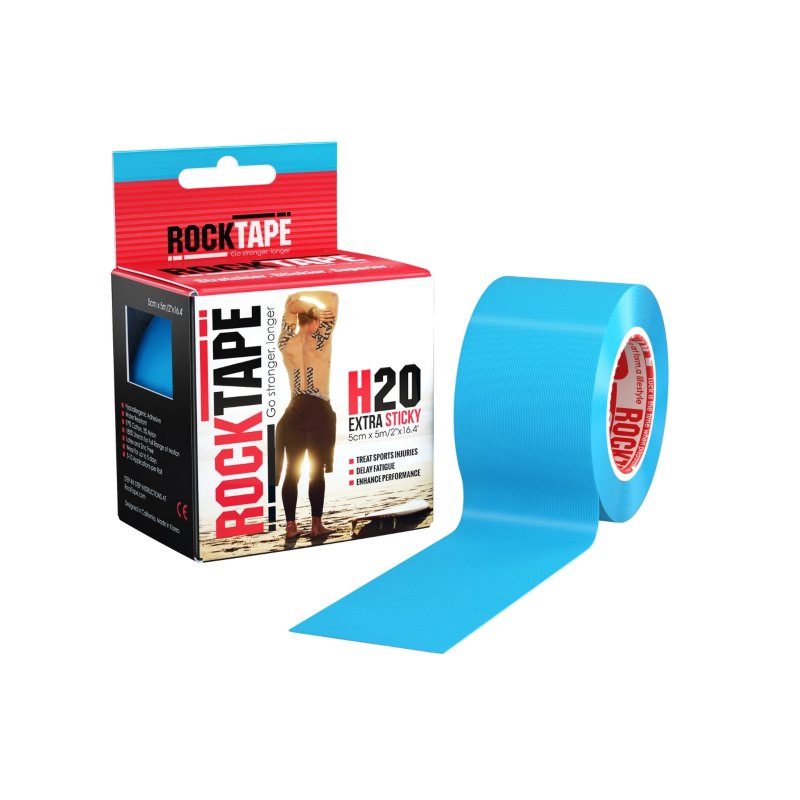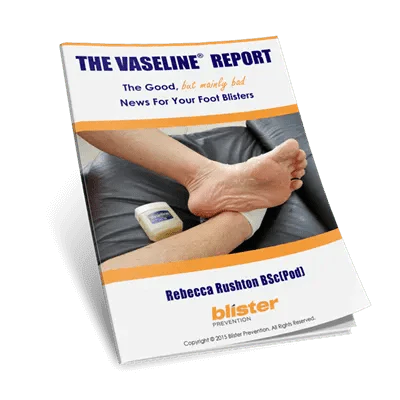This article follows the previous one highlighting my observations on blisters at Big Red Run 2016 and the experience as a whole. You can read it here. This article focuses on the three most common blisters we saw, how we attacked them preventively and how we treated them. There are a few pearls of wisdom in here that I encourage you to take on board.
1. Pinch blister: THE most common blister
Have you ever noticed how some toes look a bit triangular underneath? It’s usually the little toe, or the one next to it. They often even have a ridge of callous under there. These are the toes most likely to get pinch blisters. Have a look at your toes – are they ridged like this?
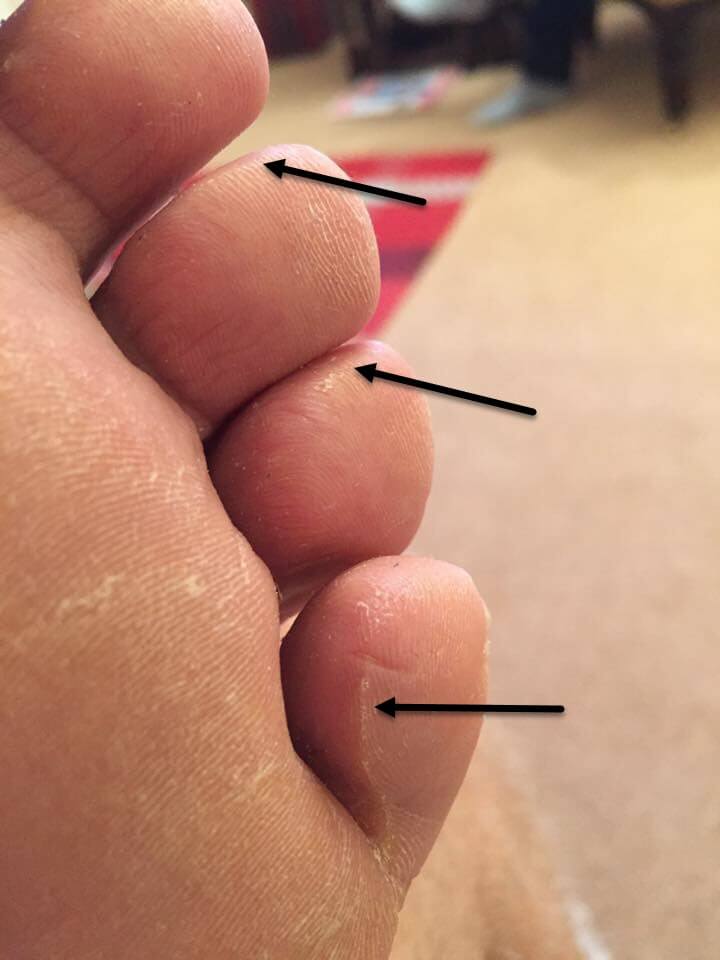
Notice the ridge on the little toe? There's even a bit of pinch callous on the 3rd and 4th toes (photo from Adam Brownhill)
Pinch blisters make a significant proportion of blisters at any athletic event. Big Red Run 2016 was no different. We saw runners with pinch blisters on three or four toes on the same foot! It's fair to say these were the most common blisters we dealt with.
More often than not, no attempt at prevention had been taken by the runner. But there were a few who had taped the toes in anticipation of pinch blisters, which was great to see. Unfortunately, taping isn’t always effective with pinch blisters.
What we did for pinch blisters
Prevention:
If we caught these before the blister developed, we tended to go for gel toe sleeves. These are the best preventive remedy, in my opinion, as long as the runner:
- Felt like they had enough room in their toe box (toebox width) – they do take up a little room.
- Understood the potential for maceration to occur, especially with the wet conditions this year. Being a stage race, runners had the opportunity to remove dressings to allow the skin to dry out in the afternoons and evenings, aided by the dry heat of the campfire.
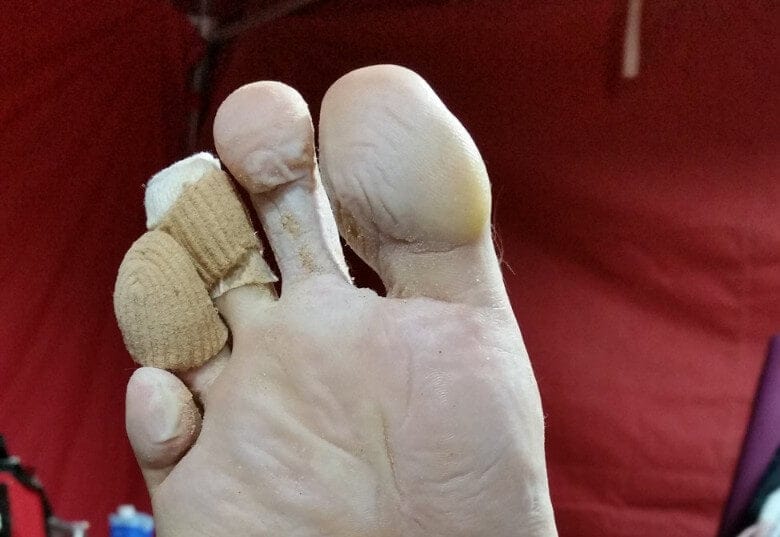
Notice the maceration on the toes? This was more of an issue on the long day (84km) and this year's race because of the wet conditions (I would not expect to see maceration to this extent in dry conditions). The remaining gel devices and dressings need to come off pronto to let the skin dry out before the next day's running.
Treatment:
If the blister required lancing, this meant we needed to apply an island dressing (if you open a blister, you need to apply antiseptic and dress it to prevent infection). Dressings on their own take up a bit of room in the toebox and we didn’t always have the room for the silicone device as well. It was a bit of a juggling act at times. Either way, runners were given the information they needed to help them decide how they should start the following day’s run: dressing only or dressing plus gel toe sleeve.
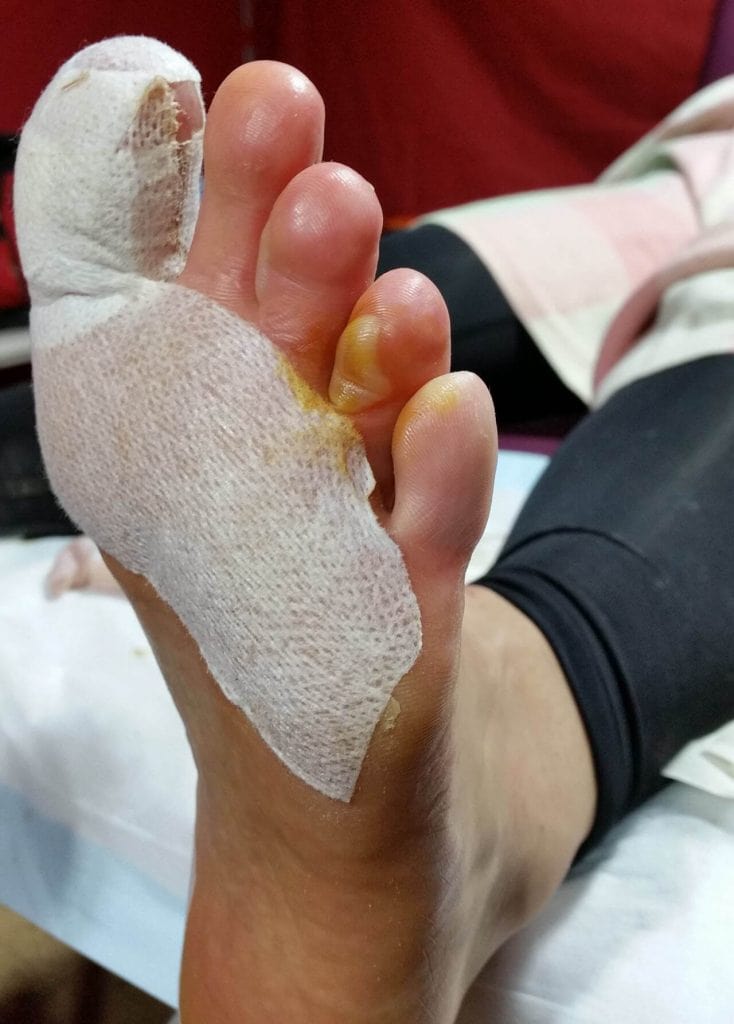
Pinch blister 4th toe that required lancing
2. The big toe (and knuckle) edge blister
Edge blisters at the big toe and big toe knuckle were the second most common blisters we saw at Big Red Run. They are one of the most common blisters I see at every ultramarathon event. Many runners had callouses that were too thick and should have been filed down before getting to Birdsville. It’s difficult to exfoliate this excess skin when it’s moist, and too late when there’s a blister underneath. One thing I’d recommend is for runners to have a small emery board in their blister kit for this purpose.
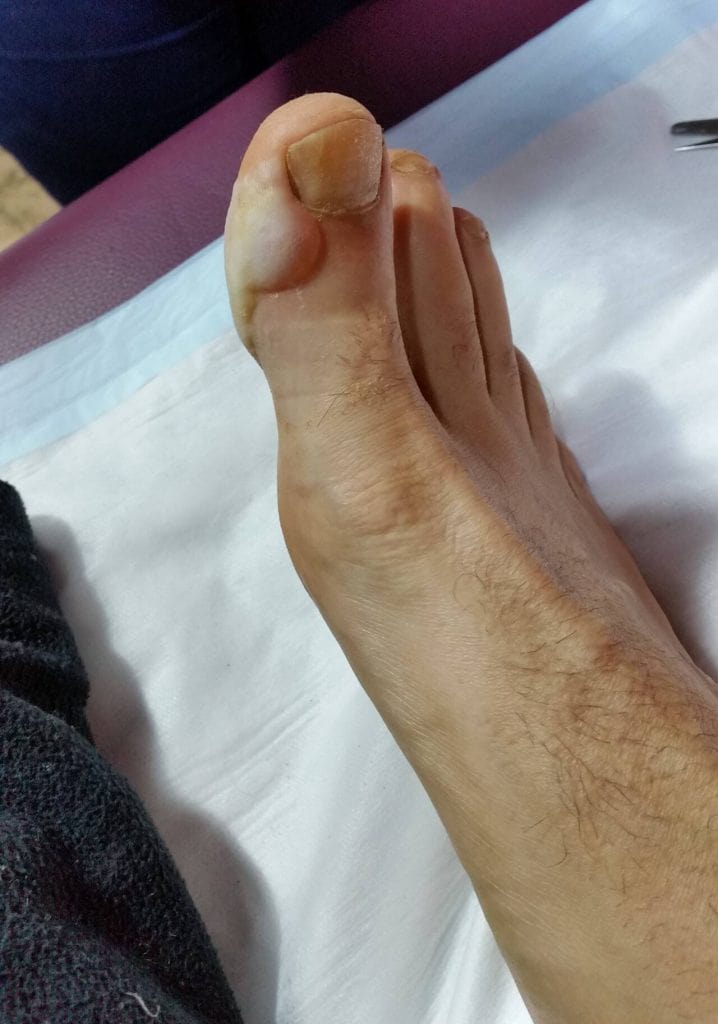
Big toe edge blister. The blister is caused at the lower edge of the toe but because of the high weightbearing forces here, the blister fluid is pushed up to a less weightbearing area. I have a high suspicion of a biomechanical cause of this blister (notice how flat the feet are - I'm thinking functional hallux limitus) which could potentially be sorted with orthotics.
What we did for big toe (and big toe knuckle) edge blisters
Prevention:
I’m uncomfortable debriding callouses immediately before a race, even if they’re obviously too bulky. Runners believe the callous is protective and the day before a race is not the time to start doing anything different.
At the end of the day, whether the callous is there or not, that area is still susceptible to blisters. Callouses are caused by skin shear just like blisters are: callouses are the chronic presentation of excessive skin shear; blisters the acute presentation of excessive skin shear.
Proper prevention for these blisters requires looking at the biomechanical factors causing the blister – weeks or months before the race. I can’t do this during a race – it opens up too much potential for aches and pains (and injury) due to an altered gait, without the time to become accustomed to the changes.
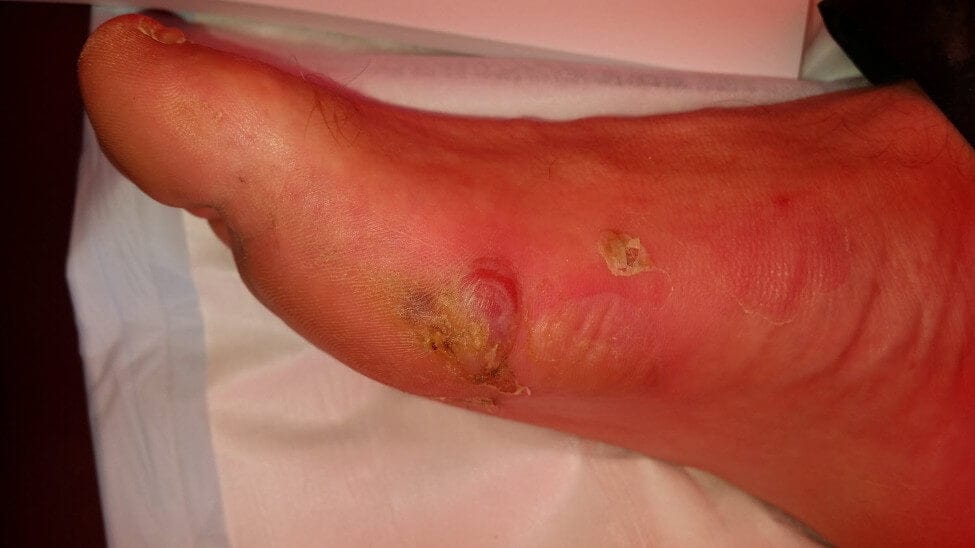
Consider a callous as a hint that you'll get a blister here (Photo from Kate Tasker)
If you have a callous anywhere on your foot, you can consider that a blister-susceptible area. If you haven’t taken the hint and seen a podiatrist, with the aim of negating the structural or biomechanical reason for that blister, you should at least have ENGO Patches in place, or another friction management strategy you trust, like you tried and trusted lubricant. Not all causes of callouses can be negated, especially some structural reasons (bunions, structural hallux limitus), and so the excess pressure persists. But anyone can take high friction levels out of the equation with ENGO Patches, using the Two-Patch Technique. Quite simply, you can't afford not to have these in place – they’re the one big thing you can do to prevent these blisters! The ENGO 4-Pack is perfect for these edge blisters.
Treatment:
Some needed lancing and some didn’t. Either way, we did a lot of donut pads for these. They worked well. I would have preferred to combine that with ENGO patches but the toe area of the shoes were generally too wet for them (they need a dry surface to stick to).
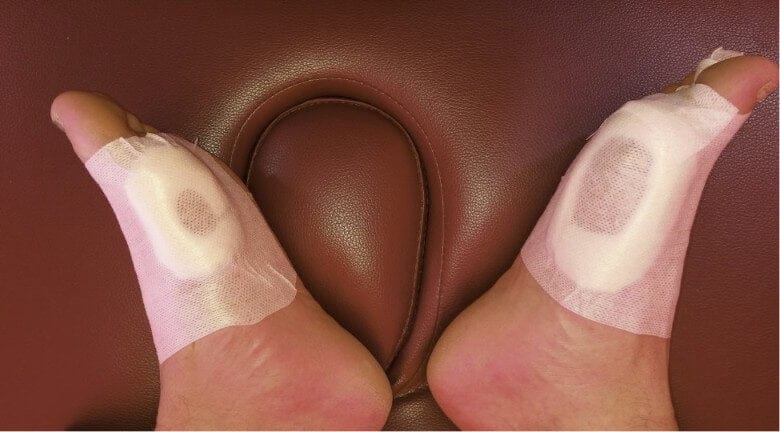
Donut pads (Photo from Kate Tasker) - donut pads in this area aren’t always comfortable. If it had been dry, I’d have simply lanced, dressd and applied Engo patches t o the shoes.
3. The heel edge blister
Heel edge blisters were also common, both on the medial side and the lateral side. Most runners had never had these before and so there was no chance of an attempt at prevention. However, my experience shows they are one of the most common blisters in multiday ultramarathon events.
I ended up with 2 small heel blisters, as you know, however they didn't surface until the 60k mark on the final day. Purely down to wear and tear over the earlier days as we spent more time on our feet than ever before. Much of it walking so a different foot strike. Two well placed Engo Patches would have prevented the blisters but I had no reason to apply the patches earlier as I had never had a prior blister problem where they surfaced. Nor any indication a problem was on its way until the damage was done. But a good learning for my next Ultra!!!!
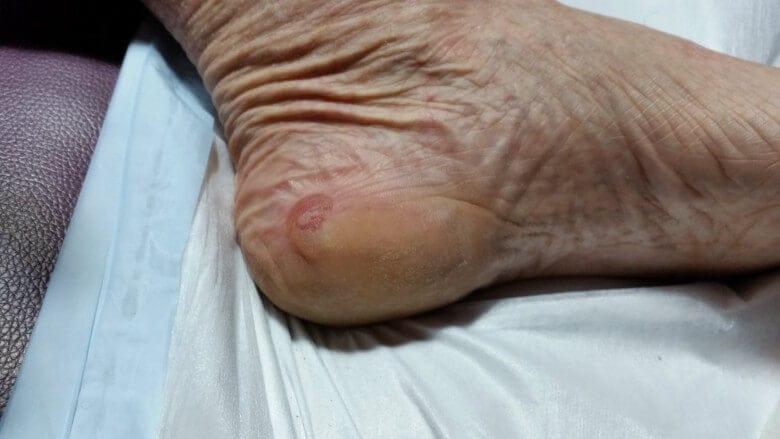
Heel edge blister (medial side of the heel)
What we did for heel edge blisters
Prevention:
We did as many ENGO Patches for these as we could, but were limited by wet shoes. If the shoes were wet, knowing that donut pads are usually uncomfortable and ineffective in this area, we used a technique which was new to me but had been used for years at this event. It is called Z-taping. It involves folding a length of thin foam material into a “Z” shape (see below). You tape it down with Fixomull. The thought is this material and technique both cushions and allows some movement between the folds of material to reduce skin shear. It helped. I don't believe the layers move across one another significantly because the entire unit of foam is taped to the foot. In essence, my thoughts are this worked via its cushioning menchanism, rather than providing an additional friction interface.
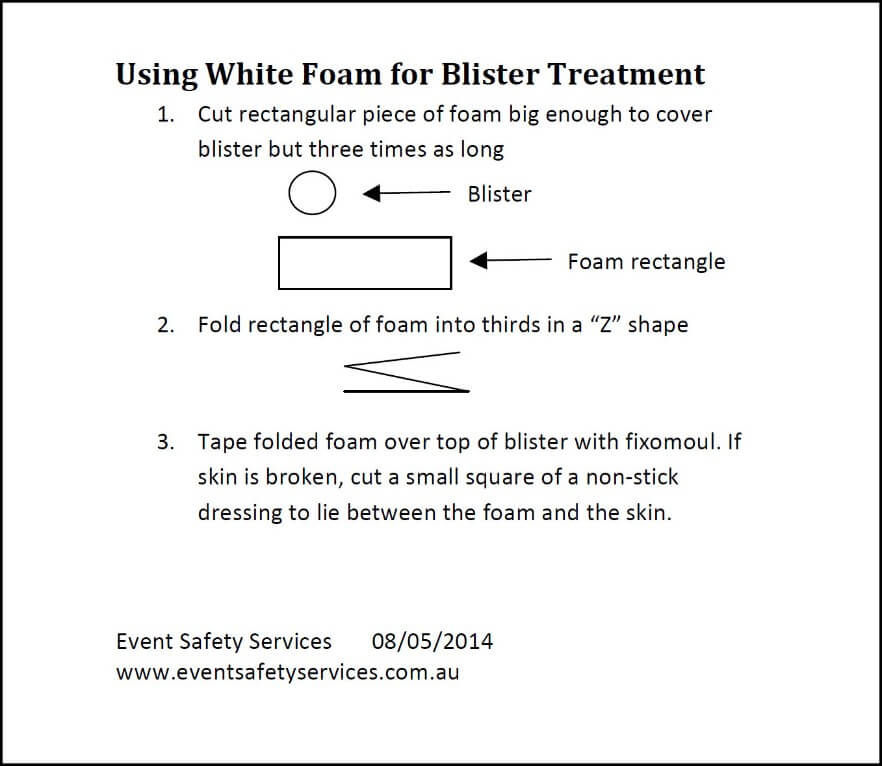
The Z-tape technique shown to me by Lucas Trihey and Adam Brownhill (Instructions from Event Safety Services). This material is packaging material - the kind of stuff that protects your new fridge or TV in its box.
Treatment:
As I said, these blisters were new to a lot of runners. They weren’t expecting them. So we were treating more than preventing. A few ENGO Patch Two-Patch Techniques but more Z-tape cushioning which was well tolerated. The picture below shows a macerated but intact heel edge blister. Remember to remove dressings and paddings if they are wet - otherwise the skin will weaken and be more likely to tear.
Note: The blister is situated some way from the edge of the heel (arrow). Weightbearing pressure squeezes the blister fluid to an area of less pressure, which is upwards for the heel area.
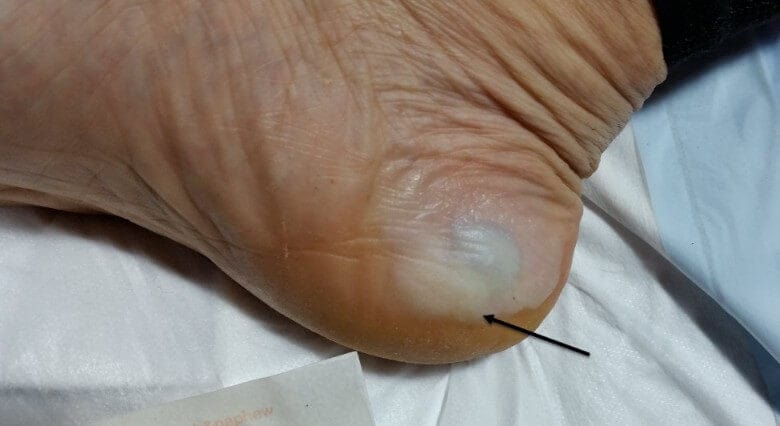
This is a macerated but intact medial heel edge blister which is blood-filled. The reason it is macerated is because the island dressing or Z-Tape was wet and stayed on for too long, a common theme in this race due to the conditions.
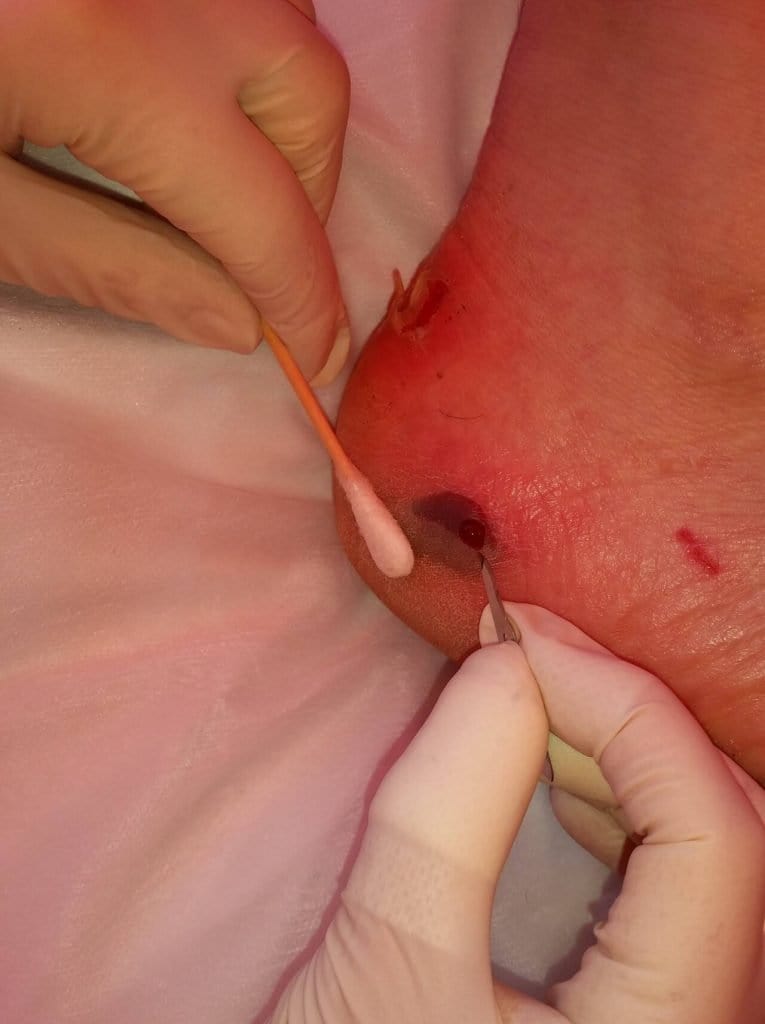
Lancing a blood-filled heel edge blister (lateral side of the heel). Also, notice the blister at the back of the heel - this is a torn blister that wasn't dressed and so the blister roof has dried up and become useless (rather than protective), in fact irritating to the raw blister base (Photo from Kate Tasker)
